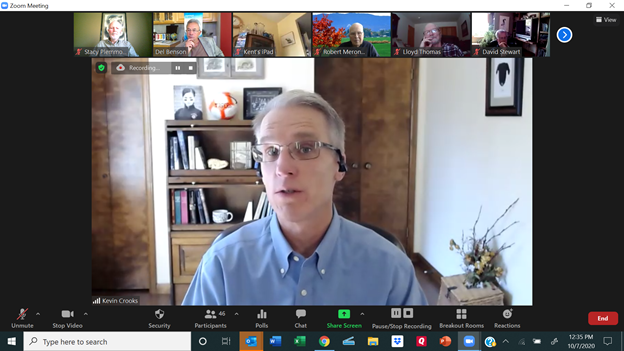 In light of the ballot issue on re-introduction of wolves into Colorado, on October 7, Dr. Kevin Crooks, professor of Fish, Wildlife, and Conservation Biology and the director of the Center for Human-Carnivore Coexistence at CSU, gave us a Zoom presentation on the background behind the possibility of re-introducing wolves into Colorado. Dr. Crooks, whose academic focus is on carnivore ecology, was not trying to advocate one way or the other; he simply wanted to present the facts. Review the presentation at https://us02web.zoom.us/rec/share/Lvk6luY9ZbDK0_Z6TqL-KqFGM8G4VZeTnH-qpFcwqc1OUoxKMVvNbHR4MeU83Cfh.RQgb6l_wItFHHi4S
In light of the ballot issue on re-introduction of wolves into Colorado, on October 7, Dr. Kevin Crooks, professor of Fish, Wildlife, and Conservation Biology and the director of the Center for Human-Carnivore Coexistence at CSU, gave us a Zoom presentation on the background behind the possibility of re-introducing wolves into Colorado. Dr. Crooks, whose academic focus is on carnivore ecology, was not trying to advocate one way or the other; he simply wanted to present the facts. Review the presentation at https://us02web.zoom.us/rec/share/Lvk6luY9ZbDK0_Z6TqL-KqFGM8G4VZeTnH-qpFcwqc1OUoxKMVvNbHR4MeU83Cfh.RQgb6l_wItFHHi4SAlthough gray wolves were historically present over much of North America (they are said to have been the most widely distributed land mammal), they were eradicated in Colorado with government support in the 1940s. Dr. Crooks pointed out that approval of the proposition on the ballot (Proposition 114) would require the Colorado Parks and Wildlife Commission to develop a plan for reintroduction of gray wolves and begin implementing that plan by Dec. 31, 2023. Although there are already a few gray wolves in the NW corner of the state, the numbers are not sufficiently large to be self-sustaining, partly because wolves are not protected immediately across the border in Wyoming (although gray wolves are listed as endangered species both federally and in Colorado), so establishing a self-sustaining population in Colorado would require active re-introduction.
There are currently active gray-wolf populations in the northern Rockies and in northern Mexico, so their absence in Colorado is a broken link between those two populations. Colorado has the habitat for wolves including some 24 million acres of public land, abundant open space, and abundant prey species (mule deer and elk), so the state appears primed for wolf re-introduction.
Potential impacts of wolf re-introduction: human safety; commercial animals; big-game populations; ecological effects; tourism. Although there is some danger of attacks on humans, there have actually been only two deaths by wolf attack (one in Alaska, another in Canada) since 1900. In Yellowstone, since wolf re-introduction in 1995, there have been no attacks on humans. Some ranchers will experience loss due to wolf predation, but in Montana most cattle die from other causes; some 1% of known losses were from wolf attack. There is apparently a greater danger of commercial livestock losses due to stress impact on numbers of pregnancies and weight gain. Although there is danger of local reduction of big game population, Dr. Crooks noted most reductions seem to have other causes. Wolves and game do coexist in several areas. In Montana, there has been no decline in elk harvest from 2004 to 2018. With high wolf density, there may be significant ecological effects; since re-introduction of wolves into Yellowstone, there has been a significant reduction of the impact of elk on vegetation, but the wolves are likely not solely responsible; a stable wolf pack may deter or reduce coyotes; translating those impacts to other ecological systems may be difficult or questionable. In Yellowstone, the presence of wolves has increased the flux of tourists through the area with its attendant economic benefit.
Tools for management of wolves and the wolf/human interactions include regulated hunting of both predators and prey; habitat management; population monitoring; proactive lethal control; creation of barriers; human presence; guardian dogs; grazing strategies; reduction of attractants (removing animals that died of other causes); and compensation for losses. There has been some attempt at birth control but with no success to date. In fact, wildlife management is commonly more about managing people (reducing societal conflict) than managing wildlife; the key is commonly persistence in cultivating human tolerances. The issue of wolf re-introduction has been contentious and hotly debated; there is typically strong public support for wolf re-introduction (in CO, some 84% of respondents were in favor in 2019) but previous studies by Colorado Parks and Wildlife (a commission on which there are no wildlife biologists) have resulted in recommendations not to re-introduce. There is considerable professional question about ballot-box biology, but in this case, although the policy may result from the ballot box, actual implementation will be directed by wildlife professionals.